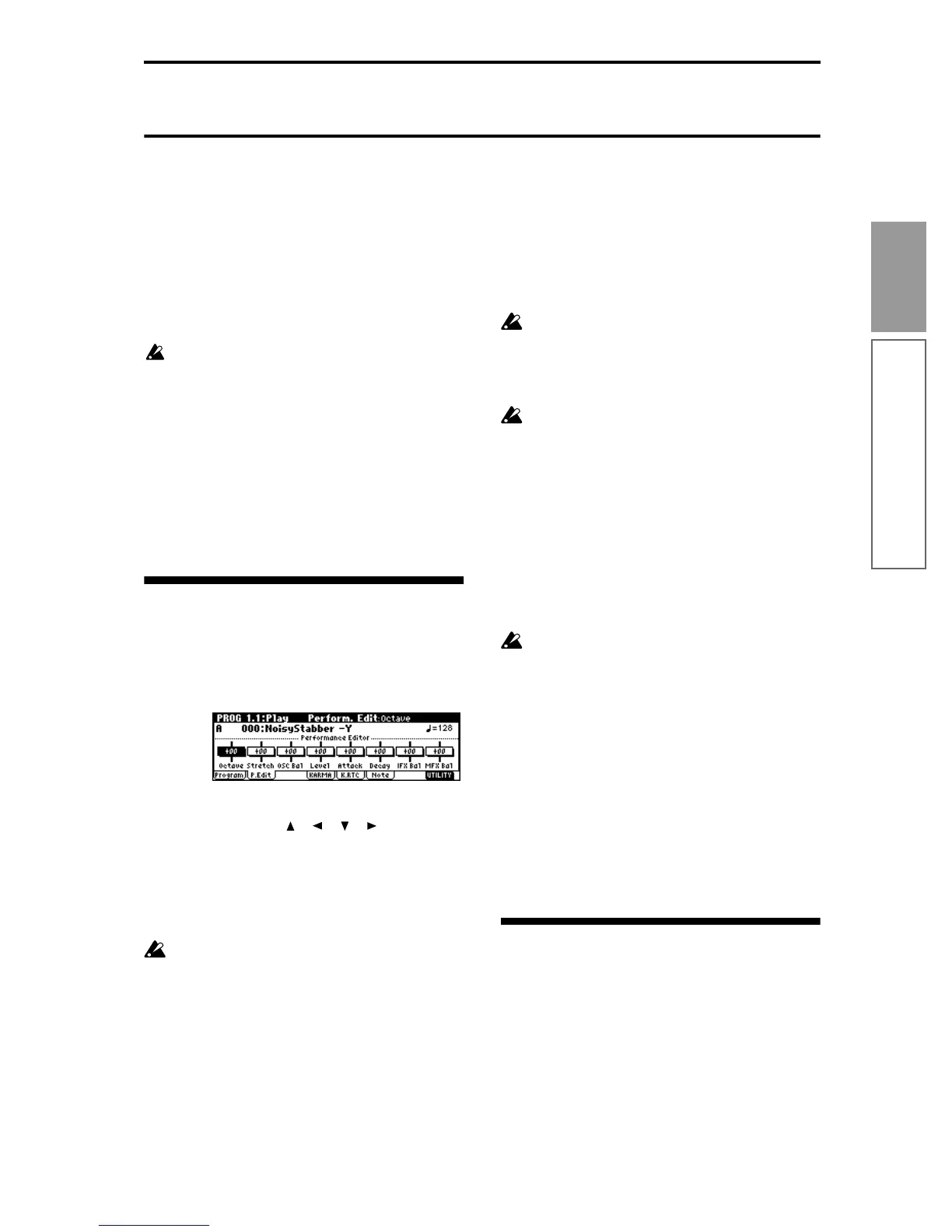33
Quick Start
Simple program editing
Simple program editing
Program sounds can be modified and created in PROG
2.1: Ed-Basic–7.3: Ed-MasterFx. However, you can also
use the “Performance Editor” to perform simple edit-
ing in PROG 1.1: Play Perform. Edit page as well.
You can also use REALTIME CONTROLS [1]–[4] knobs
to modify the sound.
Program editing refers to the process of modifying the
parameters that make up a program, in order to modify
the sound or change the controller, effect or KARMA
settings etc.
The sound that you edit using the Performance
Editor or using REALTIME CONTROLS knobs
[1]–[4] in A mode (or B mode if CC#70–79 are
assigned) can be saved by writing the program.
(However, the sound you edit using the Realtime
Controls [1]–[4] knobs will not be saved by Pro-
gram Write if the KARMA [ON/OFF] key is on.
Turn off the KARMA [ON/OFF] key before you
perform Program Write.
If you wish to keep the edited sound, you must
write the program before selecting another pro-
gram or turning off the power (☞p.38).
Performance Edit
1 Press the [PROG] key (LED lit) to enter Program
mode.
2 Press the [F2] (“P.Edit”) key.
The Perform. Edit page will appear.
3 Use the Performance Editor to adjust the sound.
Use the Cursor keys [ ], [ ], [ ], [ ] to select the
desired performance editor slider, and use the
[VALUE] controller to adjust the setting.
By using the eight sliders of the Performance Editor,
you can make overall adjustments to the sound.
When you move a slider, multiple program parame-
ters are adjusted simultaneously.
Depending on the settings of the program parame-
ters, the result may not be noticeable.
Octave
Indicates the octave setting.
Pitch Stretch
Simultaneously adjusts the transpose and tune settings
of the oscillator. This allows you to produce a variety of
tonal changes without losing the character of the origi-
nal sound.
This Performance Edit function cannot be used on
bank F.
OSC Balance
Adjusts the level balance between oscillators 1 and 2.
For programs whose “Mode (Oscillator Mode)”
(PROG 2.1: Ed-Basic, Prog Basic page) setting is
Single, oscillator 2 will not sound. Only the level
of oscillator 1 will change. For a Drums program,
this performance editor will have no effect.
Amp Level
Indicates the amp level. This will adjust the volume of
the entire program.
Attack Time
Indicates the attack time of the filter EG and amp EG.
This will adjust the speed of the attack from note-on.
In order to maximize the effect of the Attack Time
adjustment, the amp EG Start Level, Attack Level,
Start Level Modulation, and Attack Time Modula-
tion parameters are also adjusted.
Decay Time
Indicates the decay time and slope time of the filter EG
and amp EG.
IFX Balance
This simultaneously adjusts the “W/D (Wet/Dry)” bal-
ance of all insert effects 1–5.
MFX Balance
This simultaneously adjusts the Return 1 and 2 param-
eters of the master effects.
Realtime controls
These can be used to edit parameters such as the filter
cutoff frequency, resonance, the amp and filter EG, vol-
ume, portamento time, pan, pitch LFO, and master
effect send level etc. (☞p.24).

